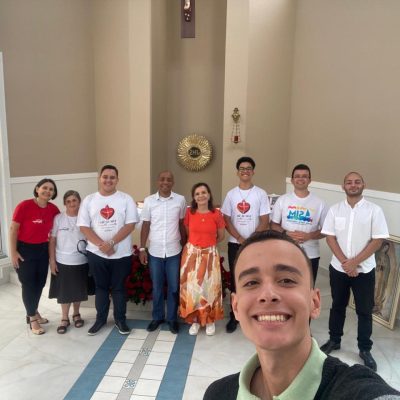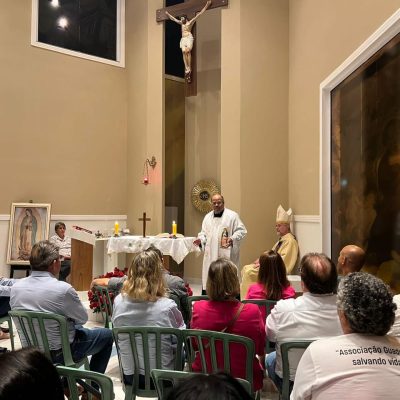Associação Guadalupe
Spirituality










Inauguration mass of the new headquarters of the Guadalupe association presided by Father Djalma, diocesan advisor and Dom Tiago - Auxiliary Bishop of the archdiocese of RJ
Masses: Tuesday to Friday at 11am
Angelus: Monday to Friday at 12pm
Chaplet of Mercy: Monday to Friday at 3pm
Cenacle: Every Tuesday at 9am
Spiritual Formation: Friday at 2pm
Our Lady of Guadalupe - Patron Saint of All America

Our Lady of Guadalupe was declared “Patroness of all America” by Pope Pius XII
On a Saturday, in the year 1531, the Blessed Virgin appeared to an indigenous man who, from his village, was walking to Mexico City to participate in catechesis and Holy Mass while on the hill of Tepeyac, near the capital. This converted Indian was called Juan Diego (canonized by Pope John Paul II in 2002).
Our Lady then told Juan Diego to go to the bishop and ask him to build a sanctuary in that place for the honor and glory of God.
The local bishop, using prudence, asked the indigenous person for a sign from the Virgin which, only in the third apparition, was granted. This happened when Juan Diego was looking for a priest for his sick uncle: “Listen, my son, there is nothing to fear, don’t be worried or scared; Do not fear this illness, nor any other unpleasantness or affliction. Am I not here, by your side? I am your giving Mother.
Did I not choose him for myself and take him into my care? What do you want more than this? Do not allow anything to distress and disturb you. As for your uncle’s illness, it is not fatal. I ask you, believe right now, because he is already healed. Dear son, these roses are the sign that you will take to the Bishop. Tell him in my name that in these roses he will see my will and fulfill it. You are my ambassador and deserve my trust. When you arrive before him, unfold your “tilma” (cloak) and show him what you carry, however, only in his presence. Tell him everything you saw and heard, omit nothing…”
Prelate saw not only the roses, but the miracle of the image of Our Lady of Guadalupe, painted prodigiously on the mantle of the humble indigenous man. He took the cloak with the image of the Blessed Virgin to the chapel, and there, amid tears, he asked Our Lady for forgiveness. It was December 12, 1531. A beautiful confirmation came when Juan Diego went to visit his uncle, who healthily narrated: “I also saw her. She came to this house and spoke to me. He also told me that he wanted a temple to be built on the hill of Tepeyac and that her image would be called ‘Saint Mary of Guadalupe’, although he did not explain why.” Faced with all this, many converted and the sanctuary was built.
The great miracle of Our Lady of Guadalupe is her own image. The fabric, made from cactus, does not last more than 20 years and has been around for more than four and a half centuries. For 16 years, the canvas was completely unprotected, the image was never retouched and to this day experts in painting and chemistry have not found any sign of corruption on the canvas.
In 1971, some experts inadvertently dropped nitric acid on the entire painting. And not even the force of such a corrosive acid damaged or stained the image. With the invention and expansion of photography it was discovered that, just as the figure of the people we speak to is reflected in our eyes, in the same way the figure of Juan Diego, the aforementioned bishop and the interpreter was reflected and recorded in the eyes of the painting of Our Lady. American scientists have come to the conclusion that these three figures stamped on Our Lady’s eyes are not a painting, but images engraved on the eyes of a living person.
Declared Pope Benedict the ship of the Church… God has not acted like this with any other nation.” Crowned in 1875 during the Pontificate of Leo XIII, Our Lady of Guadalupe was declared “Patron Saint of all America” by Pope Pius XII on October 12, 1945.
On January 27, 1979, during his apostolic trip to Mexico, Pope John Paul II visited the Sanctuary of Our Lady of Guadalupe and consecrated all of Latin America, of which the Virgin of Guadalupe is Patroness, to the Blessed Mother.
Our Lady of Guadalupe, pray for us!
JUAN DIEGO

Juan Diego was an Aztec Indian, from the region of present-day Mexico City. His Aztec name was Cuauhtlatoatzin, which means “speaking eagle”. Juan Diego is his Christian name. He was born in the year 1474 in the hillside neighborhood of de Tlayacac, which was north of Mexico City. Juan Diego belonged to the lowest caste in the Aztec empire. However, he was not a slave. He was a peasant who also dedicated himself to the manufacture of mats. He was married, lived well with his wife, but they had no children.
Encounter with the Christian faith
Juan Diego welcomed the Christian faith, attracted by the attitude and teachings of the Franciscans who arrived in Mexico in 1524. He was then 50 years old when he was baptized, along with his wife. At baptism, they received the Christian names João Diego and Maria Lúcia. Juan Diego was dedicated and pious, a man of prayer and penance. He walked twenty-two kilometers to hear the Word of God, going from his village to Mexico City.
Wife’s death
Maria Lúcia, wife of Juan Diego, died in 1529 because of an illness. So, he decided to go live with his uncle. Thus, the distance from his new home to the church decreased to fourteen kilometers. Since then, he started to take this walk every Saturday and Sunday, always leaving before dawn, to hear the Word of God. Juan Diego always walked barefoot and, on the coldest mornings, he wore a coat made of thick fabric extracted from the fibers of a cactus. This garment, similar to a cloak, was called tilma or, also, ayate. It was a garment worn by the poor, from Juan Diego’s social class.
First encounter with Our Lady of Guadalupe
On December 9, 1531, when Juan Diego was walking early in the morning to go to church, around three thirty, while he was between his village and Mount Tepeyac, the first apparition of the Virgin of Guadalupe took place. In the place known today as “Capela do Cerrinho”, Our Lady appeared and spoke to Juan Diego in his native language saying: “Juan Dieguito”, “the most humble of my children”, “my youngest son”.
The Virgin Mary’s request
Our Lady instructed Juan Diego to take her request to the Franciscan bishop Dom João de Zumárraga. The request was for a church to be built in the same place where the Virgin had appeared to Juan Diego. The bishop, however, did not believe the word of poor and humble Juan Diego. In another apparition, Our Lady asked Juan Diego to insist. Obediently, the next day, a Sunday, Juan Diego returned and spoke to the bishop. The bishop, in turn, demanded that Juan bring concrete proof of the apparition.
Humility and miracle
Poor Juan Diego returned discouraged and avoided passing by the place where he had seen the Virgin Mary, fearing that he would be reprimanded by her. The following Tuesday, December 12th, he had to go to the city again to seek help for his uncle who was very ill. And, once again, he avoided going through the same path, running away from the Virgin Mary. However, Our Lady appeared to him anyway. Juan Diego then told her about his disappointments with the bishop and said he no longer wanted to do such a job. The Mother, however, consoled him saying: “Dear little son, am I not with you? I, who am your mother?” Upon hearing these words, Juan Diego felt his heart strengthen again.
A request from Mary and miracles begin to happen
Our Lady then asked Juan Diego to go and pick flowers on Mount Tepeyac. It was winter, no flowers grew at that time. Despite this, Juan Diego obeyed. So, at the top of the mountain, in the middle of winter, he found beautiful flowers. Admired, he collected them, placed them on his cloak and went to Our Lady. The Mother asked Juan Diego to take those flowers to Bishop Dom Zumarraga as proof of the apparition.
The miracle cloak
Before the bishop, poor Juan Diego opened his cloak. At that moment, the flowers fell and, on the rustic fabric of the mantle, the image of Our Lady of Guadalupe appeared. At that same moment, his uncle said he had received a visit from the Virgin Mary and was cured. Saint Juan Diego was, at the time, fifty-seven years old.
De marginalizado a evangelizador
O bispo, maravilhado e arrependido, acreditou nas palavras do pobre Juan Diego e começou a tomar as providências para a construção da capela pedida por Nossa Senhora. Depois do milagre de Guadalupe, São Juan Diego passou a viver numa sala que ficou ao lado da capela onde se depositou por um tempo a imagem sagrada. Passou suas propriedades e negócios para seu tio e dedicou o resto de sua vida à propagação das aparições aos seus irmãos nativos, que passaram a se converter aos milhares. Demonstrou tão profundo amor à Eucaristia que o bispo lhe deu uma permissão especial para comungar o Corpo de Cristo três vezes por semana. Tal permissão era raríssima naquela época.
Imagem milagrosa
A imagem milagrosa de Nossa Senhora de Guadalupe já perdura mais de 450 anos sem explicação plausível. A tilma onde a imagem não dura mais do que 20 anos. Esta, no entanto, já dura séculos. Enfrentou incêndios e até explosões, sem sofrer um dano sequer. Estudos recentes atestam que não há nenhuma tinta impressa na tilma e não se sabe como a imagem se forma. Um oftalmologista examina os olhos de Nossa Senhora, na imagem, ampliando centenas de vezes. Na descoberta ele descobriu que os olhos da Virgem mostraram o momento exato em que Juan Diego abriu o manto e a imagem apareceu. A cena aparece nos olhos da Virgem como nos olhos de um ser humano. Já existem livros e mais livros e vários estudos científicos sobre os mistérios da imagem da Virgem de Guadalupe. E a mãe de todos os homens escolheu aquela que se julgava “as fezes do povo”, como ele mesmo repetiu várias vezes, para revelar ao mundo o seu amor pela humanidade.



